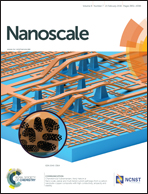Effects of nitrogen dopants on the atomic step kinetics and electronic structures of O-polar ZnO
Abstract
Oxygen-polar ZnO films are grown in step flow mode by molecular beam epitaxy. Driven by the step flow anisotropy, the growth leads to the occurrence of specific hexagonal pits in the surface. The specific pits are formed by interlacing steps of the {10![[1 with combining macron]](https://www.rsc.org/images/entities/char_0031_0304.gif)
![[4 with combining macron]](https://www.rsc.org/images/entities/char_0034_0304.gif) } facets, thus quenching the macroscopic dipole moment along the c-axis and satisfying the stabilization principles. Nitrogen (N) doping trials are then performed on the basis of the stable surface. In doping, growth remains in step flow mode but the step flow anisotropy vanishes, resulting in an obvious change of the surface morphology. Besides, a distinct acceptor state appears by in situ scanning tunneling spectroscopy analysis. First-principles calculations reveal that N readily substitutes for step-edge Zn and acts as NO2 adsorbed at the step edge. Desorption of the NO2 facilitates the formation of NO–VZn shallow acceptor complexes, which contributes to the appearance of the acceptor state. According to the peculiarities of N dopants on the O-polar surface, vicinal O-polar substrates (e.g., {10
} facets, thus quenching the macroscopic dipole moment along the c-axis and satisfying the stabilization principles. Nitrogen (N) doping trials are then performed on the basis of the stable surface. In doping, growth remains in step flow mode but the step flow anisotropy vanishes, resulting in an obvious change of the surface morphology. Besides, a distinct acceptor state appears by in situ scanning tunneling spectroscopy analysis. First-principles calculations reveal that N readily substitutes for step-edge Zn and acts as NO2 adsorbed at the step edge. Desorption of the NO2 facilitates the formation of NO–VZn shallow acceptor complexes, which contributes to the appearance of the acceptor state. According to the peculiarities of N dopants on the O-polar surface, vicinal O-polar substrates (e.g., {10![[1 with combining macron]](https://www.rsc.org/images/entities/char_0031_0304.gif)
![[4 with combining macron]](https://www.rsc.org/images/entities/char_0034_0304.gif) } substrate) are promising in ZnO : N due to the easily achieved step flow growth and high density of step edges for N incorporation.
} substrate) are promising in ZnO : N due to the easily achieved step flow growth and high density of step edges for N incorporation.


 Please wait while we load your content...
Please wait while we load your content...